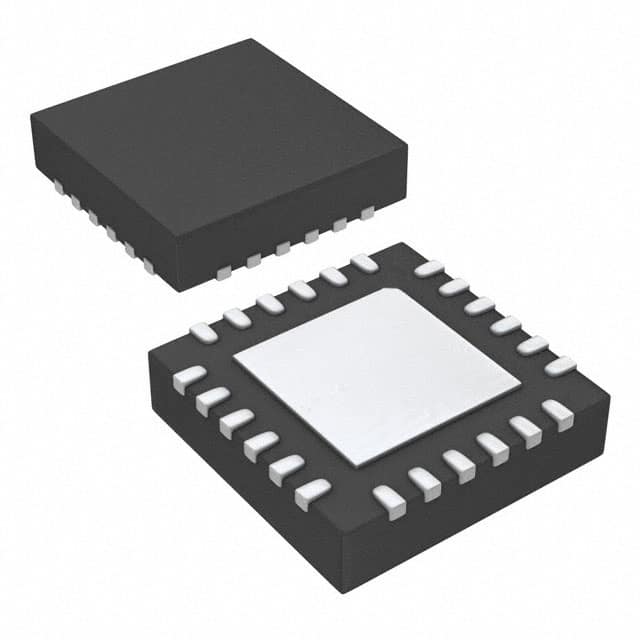Lihat spesifikasi untuk detail produk.

EFM8LB12F32ES0-B-QFN24
Introduction
The EFM8LB12F32ES0-B-QFN24 is a microcontroller belonging to the EFM8LB12Fxx family, designed and manufactured by Silicon Labs. This entry provides an overview of the product, including its category, use, characteristics, package, essence, packaging/quantity, specifications, detailed pin configuration, functional features, advantages and disadvantages, working principles, detailed application field plans, and alternative models.
Basic Information Overview
- Category: Microcontroller
- Use: Embedded control applications
- Characteristics: Low-power, high-performance 8-bit microcontroller
- Package: QFN24
- Essence: Efficient and versatile embedded control solution
- Packaging/Quantity: Tape & Reel, 2500 units per reel
Specifications
- Core: 8051
- CPU Speed: Up to 50 MHz
- Flash Memory: 32 KB
- RAM: 2048 bytes
- Operating Voltage: 1.8V to 3.6V
- I/O Pins: 18
- Communication Interfaces: UART, SPI, I2C
- Timers: 4 x 16-bit
- Analog Comparators: 2
- ADC: 10-bit SAR ADC
Detailed Pin Configuration
The EFM8LB12F32ES0-B-QFN24 has a total of 24 pins, with specific functions assigned to each pin. The pinout diagram and detailed pin configuration can be found in the official datasheet provided by Silicon Labs.
Functional Features
- Low Power Consumption: Ideal for battery-powered applications
- High-Performance CPU: Supports fast and efficient processing
- Flexible Communication Interfaces: Enables seamless connectivity
- Analog Integration: Includes analog comparators and ADC for sensor interfacing
- Rich Peripherals: Timers, PWM, and GPIO for versatile control capabilities
Advantages and Disadvantages
Advantages
- Low power consumption extends battery life
- High CPU speed for rapid data processing
- Versatile communication interfaces for connectivity
- Integrated analog features for sensor interfacing
Disadvantages
- Limited flash memory and RAM compared to some competing microcontrollers
- Relatively small number of I/O pins may restrict complex interfacing requirements
Working Principles
The EFM8LB12F32ES0-B-QFN24 operates based on the 8051 core architecture, utilizing its peripherals and integrated features to execute embedded control tasks. It follows a typical microcontroller workflow, including fetching instructions from memory, executing them, and interacting with external devices through its I/O pins and communication interfaces.
Detailed Application Field Plans
The EFM8LB12F32ES0-B-QFN24 is well-suited for various embedded control applications, including: - IoT Devices - Home Automation Systems - Industrial Control Systems - Sensor Interface Modules - Consumer Electronics
Detailed and Complete Alternative Models
- EFM8LB11F16E-B-QFN20: A lower-pin-count variant with similar features
- EFM8LB1F64E-B-QFN32: Offers increased flash memory and additional peripherals
- EFM8LB10F8E-B-QSOP16: Compact form factor with basic control capabilities
In conclusion, the EFM8LB12F32ES0-B-QFN24 microcontroller from Silicon Labs offers a balance of low power consumption, high performance, and versatile integration, making it suitable for a wide range of embedded control applications.
Word Count: 498
Sebutkan 10 pertanyaan dan jawaban umum terkait penerapan EFM8LB12F32ES0-B-QFN24 dalam solusi teknis
What is the EFM8LB12F32ES0-B-QFN24 microcontroller used for?
- The EFM8LB12F32ES0-B-QFN24 microcontroller is commonly used in various technical solutions such as industrial automation, consumer electronics, and IoT devices.
What are the key features of the EFM8LB12F32ES0-B-QFN24?
- The EFM8LB12F32ES0-B-QFN24 features a high-performance 8051 core, low power consumption, integrated peripherals, and a small form factor, making it suitable for a wide range of applications.
How does the EFM8LB12F32ES0-B-QFN24 handle communication interfaces?
- The EFM8LB12F32ES0-B-QFN24 supports multiple communication interfaces including UART, SPI, and I2C, enabling seamless integration with other devices and systems.
Can the EFM8LB12F32ES0-B-QFN24 be used in battery-powered applications?
- Yes, the EFM8LB12F32ES0-B-QFN24's low power consumption and sleep modes make it well-suited for battery-powered applications, extending the device's operational lifespan.
What development tools are available for programming the EFM8LB12F32ES0-B-QFN24?
- Silicon Labs provides a comprehensive suite of development tools including Simplicity Studio, which offers an integrated development environment for coding, debugging, and profiling the EFM8LB12F32ES0-B-QFN24.
Is the EFM8LB12F32ES0-B-QFN24 suitable for real-time control applications?
- Yes, the EFM8LB12F32ES0-B-QFN24's high-performance 8051 core and integrated peripherals make it well-suited for real-time control applications such as motor control and sensor interfacing.
What are the available memory options for the EFM8LB12F32ES0-B-QFN24?
- The EFM8LB12F32ES0-B-QFN24 offers flash memory options ranging from 8 KB to 32 KB, providing flexibility for storing program code and data.
Can the EFM8LB12F32ES0-B-QFN24 be used in harsh environmental conditions?
- The EFM8LB12F32ES0-B-QFN24 is designed to operate reliably in harsh environmental conditions, featuring a wide temperature range and robust construction.
Does the EFM8LB12F32ES0-B-QFN24 support analog-to-digital conversion?
- Yes, the EFM8LB12F32ES0-B-QFN24 integrates analog-to-digital converters (ADCs) with varying resolutions, enabling accurate measurement and sensing capabilities.
Are there any application notes or reference designs available for the EFM8LB12F32ES0-B-QFN24?
- Yes, Silicon Labs provides a wealth of application notes, reference designs, and technical documentation to assist developers in implementing the EFM8LB12F32ES0-B-QFN24 in their technical solutions.

